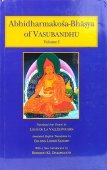Purushapura, Puruṣapura, Purusha-pura: 8 definitions
Introduction:
Purushapura means something in Buddhism, Pali, Hinduism, Sanskrit, the history of ancient India. If you want to know the exact meaning, history, etymology or English translation of this term then check out the descriptions on this page. Add your comment or reference to a book if you want to contribute to this summary article.
The Sanskrit term Puruṣapura can be transliterated into English as Purusapura or Purushapura, using the IAST transliteration scheme (?).
In Buddhism
Theravada (major branch of Buddhism)
Source: Dhamma Study: CetasikasPurushapura was one of the principal centres for the expansion of Mahâyâna Buddhism. Buddhist missionaries are thought to have be sent to Ghandara not long after the Parinirvâna of the Buddha . Buddhism was firmly rooted in this area under the reign of Emperor Ashoka, whose grandfather Chandragupta Maurya had already extended his imperial power in this western direction .
Purushapura (present day Peshawar), Ghandara, Kashmir and parts of Punjab were the springboard for Buddhism to Afghanistan, parts of Iran and Central Asia and further to the north and to the east.
Theravāda is a major branch of Buddhism having the the Pali canon (tipitaka) as their canonical literature, which includes the vinaya-pitaka (monastic rules), the sutta-pitaka (Buddhist sermons) and the abhidhamma-pitaka (philosophy and psychology).
Mahayana (major branch of Buddhism)
Source: archive.org: Bulletin of the French School of the Far East (volume 5)Puruṣapura (पुरुषपुर) (in Chinese: Fou-leou-cha-fou-lo) refers to one of the fifty-five kingdoms enumerated in chapter 17 of the Candragarbha: the 55th section of the Mahāsaṃnipāta-sūtra, a large compilation of Sūtras (texts) in Mahāyāna Buddhism partly available in Sanskrit, Tibetan and Chinese.—In the Candragarbhasūtra, the Bhagavat invites all classes of Gods and Deities to protect the Law [dharma?] and the faithful in their respective districts.—In Puruṣapura, the following deities are appointed (among others): The Gandharva Nandi; the Yakṣa Maṇipuṣpa; the Nāgarājas Kaṭa and Apalāla; the great and terrible Garuḍa; the Asura Ki-to-sun-ti; the Goddess To-lou-si.
Puruṣapura (पुरुषपुर) (in Chinese: Fou-leou-cha-fou-lo) is the name of an ancient kingdom associated with Puṣya or Puṣyanakṣatra, as mentioned in chapter 18.

Mahayana (महायान, mahāyāna) is a major branch of Buddhism focusing on the path of a Bodhisattva (spiritual aspirants/ enlightened beings). Extant literature is vast and primarely composed in the Sanskrit language. There are many sūtras of which some of the earliest are the various Prajñāpāramitā sūtras.
India history and geography
Source: archive.org: Personal and geographical names in the Gupta inscriptionsPuruṣapura (पुरुषपुर) is a place name ending in pura mentioned in the Gupta inscriptions. Puruṣapura is also known as Peshawar in the way that pura is changed to war.
Source: Shodhganga: New look on the kushan bengaliPurushapura was another important Kushan town in the Gandhara region. The modern name of Peshawar was given to it by Akbar, the great Mughal emperor, who changed its name from Parashawar to Peshawar meaning the ‘frontier town’. Both the Chinese pilgrims, Fa-hsien and Hsuan-Tsang visited this place and spoke highly of it as a Buddhist centre. The Chinese accounts along thus, strongly suggest that it was traditionally associated with the Kushan people when they visited the place.

The history of India traces the identification of countries, villages, towns and other regions of India, as well as mythology, zoology, royal dynasties, rulers, tribes, local festivities and traditions and regional languages. Ancient India enjoyed religious freedom and encourages the path of Dharma, a concept common to Buddhism, Hinduism, and Jainism.
Languages of India and abroad
Sanskrit dictionary
Source: DDSA: The practical Sanskrit-English dictionaryPuruṣapura (पुरुषपुर).—Name of the capital of Gāndhāra, q. v.
Derivable forms: puruṣapuram (पुरुषपुरम्).
Puruṣapura is a Sanskrit compound consisting of the terms puruṣa and pura (पुर).
Source: Cologne Digital Sanskrit Dictionaries: Monier-Williams Sanskrit-English DictionaryPuruṣapura (पुरुषपुर):—[=puruṣa-pura] [from puruṣa] n. Name of the capital of Gāndhāra, the modern Peṣāwar (پيشاور), [cf. Lexicographers, esp. such as amarasiṃha, halāyudha, hemacandra, etc.]
[Sanskrit to German]
Sanskrit, also spelled संस्कृतम् (saṃskṛtam), is an ancient language of India commonly seen as the grandmother of the Indo-European language family (even English!). Closely allied with Prakrit and Pali, Sanskrit is more exhaustive in both grammar and terms and has the most extensive collection of literature in the world, greatly surpassing its sister-languages Greek and Latin.
See also (Relevant definitions)
Partial matches: Purusha, Pura.
Full-text: Peshawar, Manipushpa, Apalala, Nandi, Asanga, Vasubandhu, Kanishkastupa, Kata, Gandhara, Pushya, Pura.
Relevant text
Search found 5 books and stories containing Purushapura, Purusapura, Purusa-pura, Puruṣapura, Purusha-pura, Puruṣa-pura; (plurals include: Purushapuras, Purusapuras, puras, Puruṣapuras). You can also click to the full overview containing English textual excerpts. Below are direct links for the most relevant articles:
A Record of Buddhistic Kingdoms (by Fa-Hien)
Buddhist records of the Western world (Xuanzang) (by Samuel Beal)
Chapter 2 - Country of ’O-yu-t’o (Ayodhya) < [Book V - Six Countries]
Chapter 21 - Country of Kien-t’o-lo (Gandhara) < [Book II - Three Countries]
Reviews < [March-April 1935]
A Dictionary Of Chinese Buddhist Terms (by William Edward Soothill)
Maha Prajnaparamita Sastra (by Gelongma Karma Migme Chödrön)
Introduction to third volume < [Introductions]
Related products
